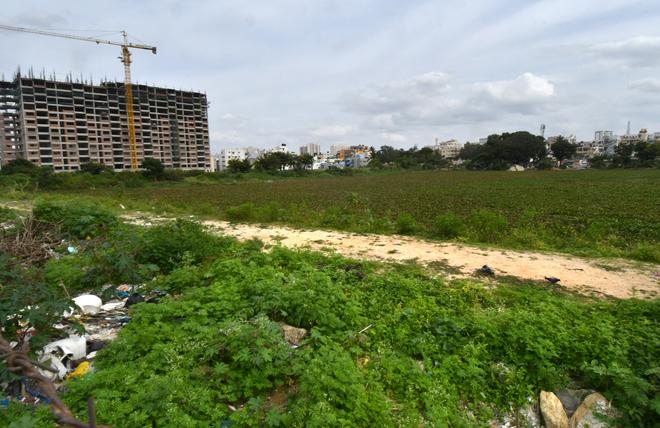
Recent flooding in Mahadevapura zone and other areas, following heavy rain, exposed how the civic agencies failed miserably in protecting lakes and storm water drains.
A year before, in its report on “Performance Audit of Management of stormwater in Bengaluru Urban Area’‘, the Comptroller and Auditor General of India (CAG) had exposed how the Bruhat Bengaluru Mahanagara Palike (BBMP) and other civic agencies played their role in the vanishing of lakes and deterioration of storm water drains over the years.
No data
It revealed that the BBMP, which runs the tech capital of the country, does not possess fool-proof data on the total number/length and nature of different types of drains in its jurisdiction. The CAG also noted that there were “significant discrepancies in details pertaining to water bodies and storm water drains in master plans prepared by BDA and BBMP.” The civic agencies ignoring encroachments of storm water drains, poor execution and ‘undue’ favours to contractors while executing storm water related works and many other derelictions were exposed in the report.
The report states that as per the information provided by the lake division of the (in December 2020) BBMP, the city had 210 lakes in its jurisdiction out of which 66 lakes were yet to developed, 18 lakes with a total area of over 254 acres reported as disused lakes that include Chennamana Kere, Chikkalasandra, Lingarajapuram lakes, and others.
Back in 1800s
Quoting the Indian Institute of Science studies, the report states that the city (covering an area of 741 sq km) had 1,452 water bodies with a total storage capacity of 35 tmcft during the early 1800s. By 2016, the number of water bodies in the same area reduced to 194 with a storage capacity of 5 tmcft. The current storage capacity which has further declined due to silting is merely 1.2 tmcft (2016).
The report made a revelation that 41 and 51 water bodies, which existed in Koramangala and Vrishabhavathi valleys, respectively, as per the cadastral map (prepared through field survey during early 1900s) were reduced to 8 and 13 by the year 2008 indicating the severity of lake conversion. Further, the wetland system (lakes, tanks, kere and katte), which contributed about 479.48 ha (0.75%) and 215.46 ha (2.24%) to the geographical area of the valleys as per the cadastral map decreased to 262.37 ha and 62.05 ha during 2016/2017 indicating erosion due to land use changes.
As per the study, total length of drains (primary and secondary) as per cadastral maps (early 1900s) was 113.24 km and 226.29 km in Koramangala and Vrushabhavathi valleys respectively, which was reduced to 62.84 km and 111.72 km by 2016/2017. In Koramangala Valley, which witnessed severe flooding, the length of two drains which merge before entering into Bellandur Lake was reduced from 338 m to 136 m between the years 2008 and 2016 which allowed constructions thereby affecting the free flow of stormwater. In Vrishabhavathi valley, the drain passing along the border of Hosakerehalli lake was remodeled and diverted to flow through the lake, thereby reducing the area of the lake.
Mixing of sewage
In its observation on the status of storm water drains in the city, the report states that rampant mixing of sewage (780MLD) with storm water is a serious problem. “Sewerage lines were drawn inside the SWDs and a large quantity of sewage was illegally let into SWDs. Joint inspection of drains confirmed the existence of sewerage lines within SWDs and sewage being discharged into the SWDs directly or through fractured manholes at many places. Since the water in SWDs is not treated in the same manner as sewage, the untreated sewage is flowing into water bodies and affecting the quality of ground water adversely. This carries substantial risk of spurt in vector/water borne diseases such as dengue, typhoid, cholera, hepatitis and adverse environmental outcomes including disappearance of biodiversity and aquatic ecosystems,” states the report.
The Chief Health Officer (Public Health), BBMP, confirmed an outburst of cholera in the city during March 2020 and stated that seven out of the 25 suspected cases had been confirmed as cholera. The officer had attributed that sewage flowing in open SWDs to the spreading of the epidemic.
The CAG report had made several recommendations to fix the flooding problem in the city. However, the report has been gathering dust and most of the recommendations not implemented. Here are the key recommendations:
Formulation of comprehensive policy that recognizes urban run off as potential source of water requiring a clear plan of action for conservation in consonance with NDM guidelines.
BBMP and BWSSB should jointly prepare a plan of action to prevent sewage flow into storm water drains, exploring letting treated water to water bodies in the city.
Notifying revised master plan to prevent encroachments water bodies.
BBMP to come up with an action plan to recover cost amounts from all the contractors who had violated norms and blacklist them. Action to be initiated against officials responsible for violations.
State Government should conduct a detailed investigation into the issues regarding preparation of incomplete and deficient DPRs, loss of files by SWD division, payments made under questionable circumstances and take appropriate action based on the findings of the investigation.
BBMP needs to escalate its efforts to conduct robust surveys to identify and evict all encroachments on SWDs and maintain the stipulated buffer zone,” the report states.







